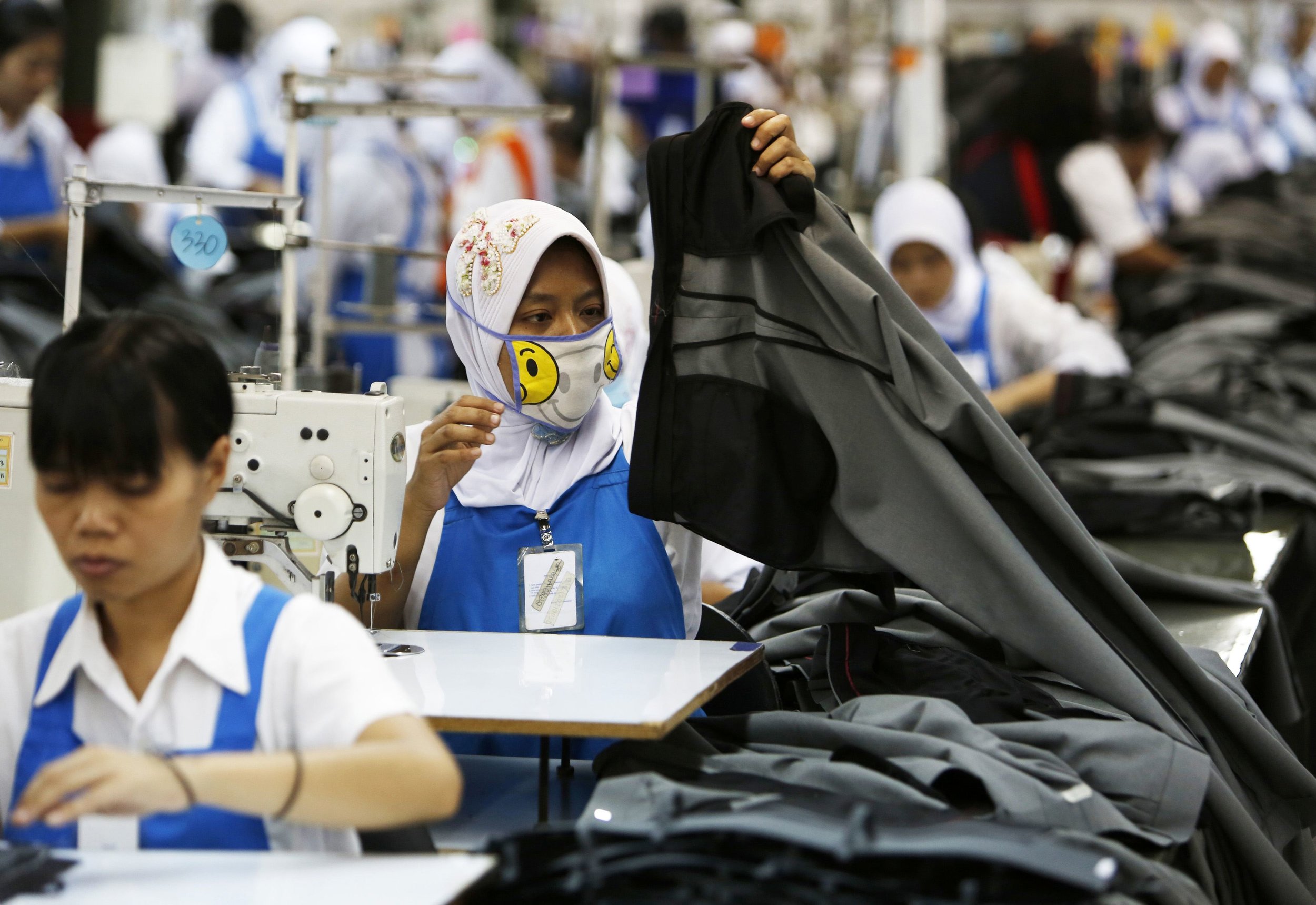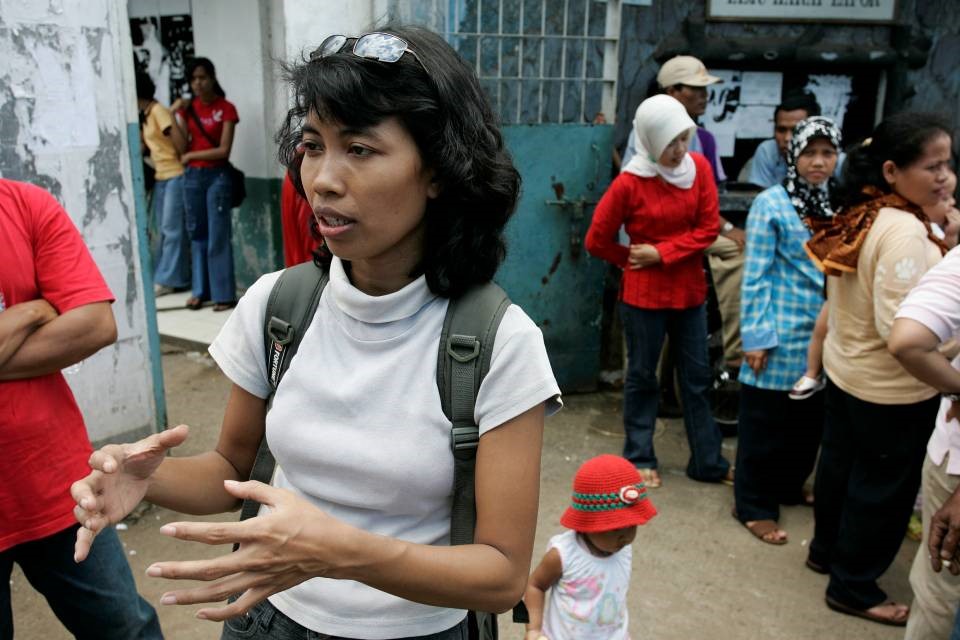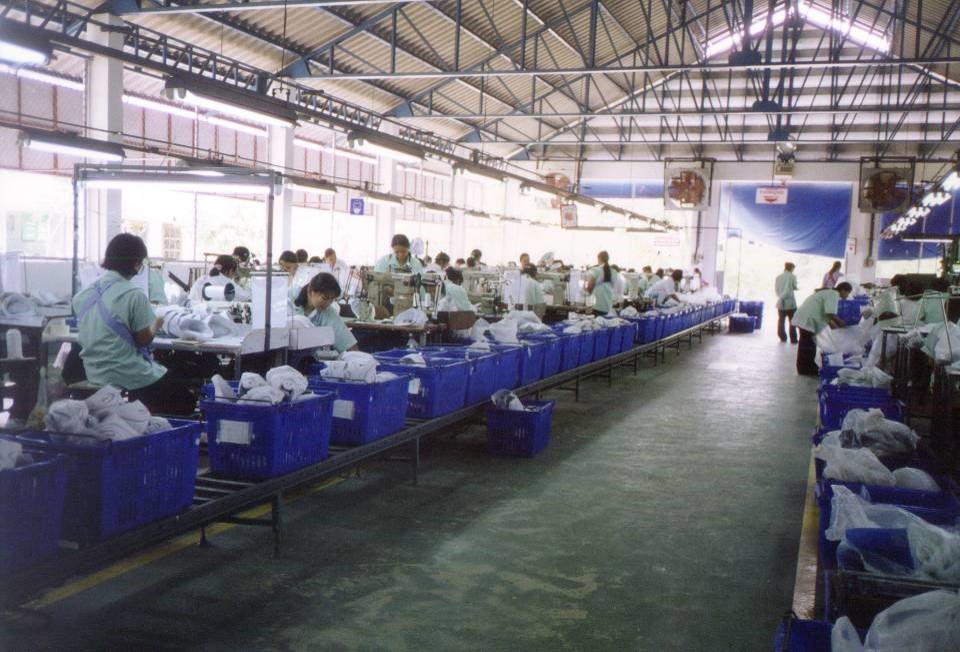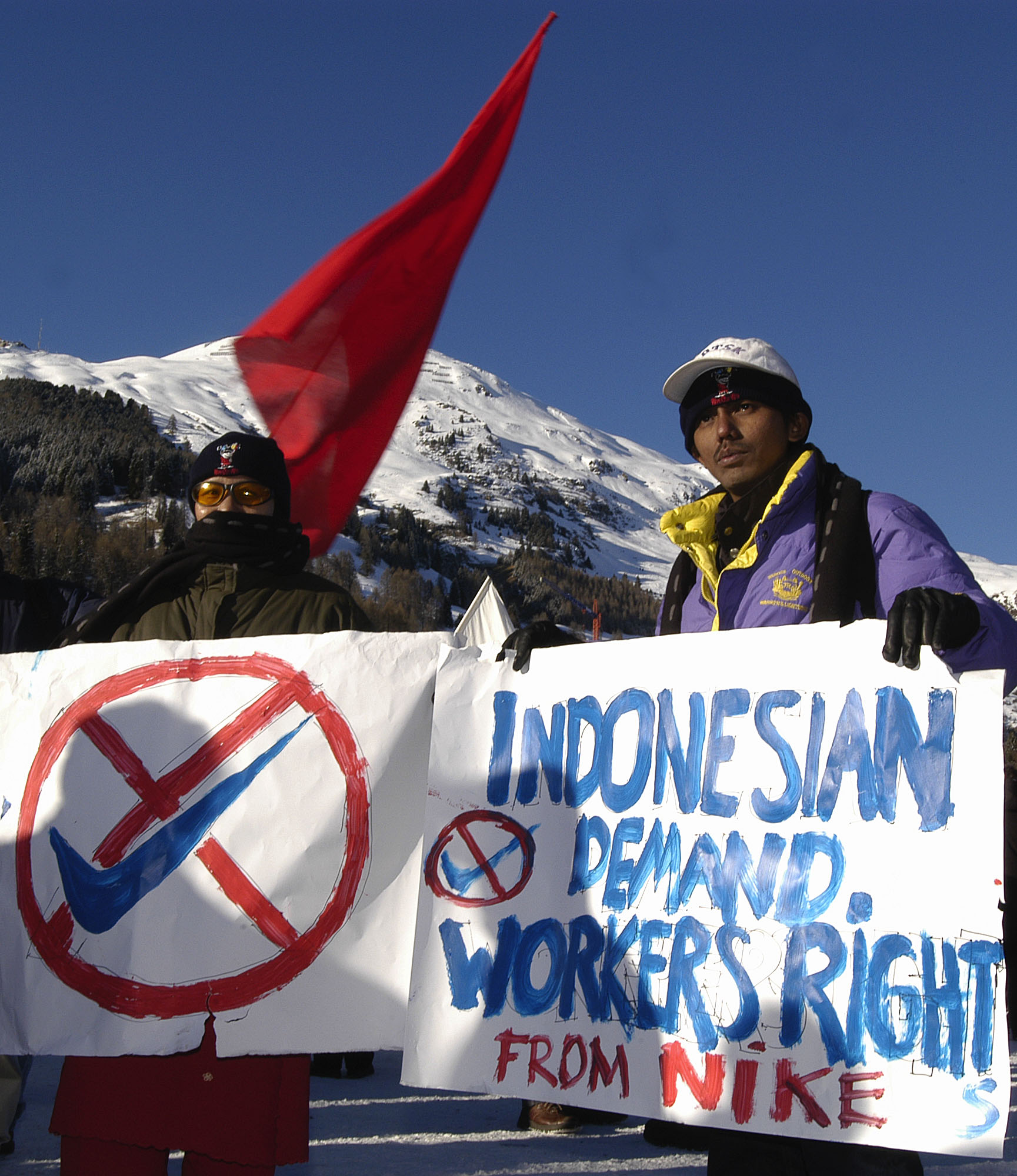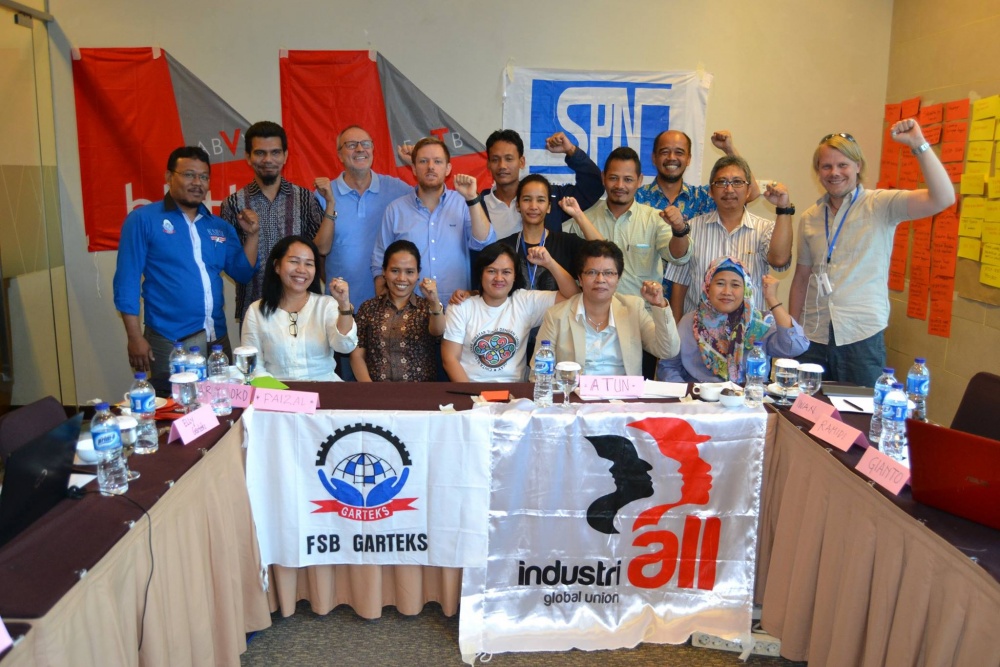Non-judicial mechanisms in global footwear and apparel supply chains: Lessons from workers in Indonesia
Dr Tim Connor, Dr Annie Delaney, Sarah Rennie
This case study describes how Indonesian garment and footwear workers, and allied organisations have used a combination of strategies to pursue their rights, which includes engaging with local and international non-judicial mechanisms. The case study analyses their efforts to influence the local and global forces that determine their working conditions. Major footwear brands who sell their goods globally produce the factories under study.
Issues
Although Indonesia’s labour laws are relatively progressive, its enforcement strategy and industrial dispute resolution remains weak. Workers who collectively organise and take industrial action in pursuit of improved wages and conditions can face significant intimidation and threats to their job security. The underlying commercial model of the global manufacturing sector does not promote improved working conditions. Suppliers are under pressure to minimise the cost and speed of production while still meeting quality requirements, and these pressures are frequently passed on to workers.
Non-judicial redress mechanisms
The Indonesian trade unions we interviewed generally use a combination of strategies to pursue rights grievances, including strikes and protests; engaging the media; collaborating with global campaign networks to influence the reputation of brands in consumer and investor markets; reporting rights violations to local police and other law enforcement agencies; and lodging complaints with multiple local and international non-judicial redress mechanisms.
The expectations the trade unions have of a non-judicial redress mechanism is based on their previous experiences with it. Unions often use mechanisms to achieve purposes that would not necessarily have been envisaged by those who designed the mechanism’s grievance handling procedure. In order to understand how non-judicial redress mechanisms can contribute to the resolution of rights-based grievances, it is therefore necessary to look beyond their role as discrete processes and consider how they interact with other judicial and non-judicial mechanisms and other claim-making strategies. Our research suggests that, considered from this perspective, non-judicial redress mechanisms can play a more useful role than is apparent when they are considered in isolation. Arguably, this should be taken into account when non-judicial redress mechanisms are designed or reformed, so that each mechanism can play the most useful role it can within the array of possible means of seeking redress.
However, while we found evidence that combining strategies in this way can result in improved respect for workers’ rights, in those cases where some form of human rights redress was achieved, it was generally partial and in some cases the improvements in respect for human rights proved to be temporary. As such, while strategically pursuing simultaneous complaints and other claim-making strategies through multiple grievance mechanisms operating at different scales can enhance Indonesian garment workers’ chance of achieving meaningful redress, this enhancement should not be overstated.
An executive summary of the report can be found below.
Executive summary
Workers in Indonesian factories that produce footwear and garments for some of the world’s most profitable brand names are frequently denied basic rights, including the freedom to organise and collectively bargain and a decent wage. Against this backdrop of weak law enforcement, workers face considerable barriers in seeking justice for violations of their rights. In an environment sometimes very hostile to labour activism, worker representatives who actively organise and demand improved conditions face intimidation, discrimination and threats to their economic security.
To combat these challenges, Indonesian trade unions are increasingly utilising non-judicial mechanisms, including various international human-rights–based mechanisms, to strengthen their chances of obtaining redress for violations of workers’ rights. This report examines the use of such mechanisms by Indonesian trade unions representing workers employed within the supply chains of global footwear and apparel brands, focusing particularly on their efforts to exercise freedom to organise and collectively bargain and the right to a decent wage. To illustrate the considerable challenges involved, the report is linked to an online supplement that provides a detailed chronological narrative of one union’s struggle over a 17-year period to seek redress for multiple labour violations at a particular footwear manufacturer (Factory C).* The report’s analysis also draws from a broad range of other case studies within the sector.
Key lessons
Our research indicates that, rather than relying on any single redress mechanism to deliver justice, Indonesian trade unions in this industry generally use multiple strategies to pursue particular grievances, including engagement with non-judicial mechanisms, formal legal complaints and informal campaigning strategies. The expectations they have of each non-judicial mechanism is based on their previous experiences with it and the unions often use some of those mechanisms to achieve purposes that would not necessarily have been envisaged by those who designed the mechanism’s grievance handling procedure. For example, grievances were sometimes lodged with state non-judicial mechanisms such as the Indonesian Human Rights Commission, not because the union expected that the Commission would investigate (they know how under-resourced it is), but because they have found that if local police know that there is a possibility of a Commission investigation then the police will be more likely to act on a complaint. Lodging grievances with the Victim and Witness Protection Agency (LPSK) served a similar purpose, but that agency also provided support to complainants who were afraid their complaint might put them in personal danger. Regular supportive phone contact with LPSK (and calls from LPSK to the police to check on the progress of their investigations) reassured those workers and gave them confidence to continue to seek redress through other mechanisms, even though the LPSK’s capacity to directly assist them to pursue the grievance was very limited.
In each of the cases we researched, this complex strategic engagement with multiple grievance mechanisms was supplemented by efforts to generate local and/or international media coverage of the grievance, using a variety of methods, including demonstrations, connections with national and global activist networks and social media outlets such as YouTube and Facebook. The unions’ experience has been that if they can activate sufficient interest in their dispute through engagement with traditional media and/or social media then it can not only increase the pressure on local and international companies to take their grievance more seriously but, in the context of a relatively weak state commitment to the rule of law, it can also influence the way state institutions (such as the police and the courts) respond to their grievance.
In order to understand how non-judicial mechanisms can contribute to the resolution of rights-based grievances, it is therefore necessary to look beyond their role as discrete processes and consider how they interact with these other strategies. Our research suggests that, considered from this perspective, non-judicial mechanisms can play a more useful role than is apparent when they are considered in isolation. Arguably this should be taken into account when non-judicial mechanisms are designed or reformed, so that each mechanism can play the most useful role it can within the array of possible means of seeking redress.
Worker representatives reported that non-judicial mechanisms can be particularly useful for their ability to target stakeholders that are beyond the jurisdictional reach of traditional law-enforcement agencies. In a highly globalised sector, achieving improvements of working conditions involves influencing the local and global forces that influence those conditions. For this reason, Indonesian trade unions in the garment and footwear sector use non-judicial mechanisms to target not only the local manufacturer but also corporate decision makers at the international level, particularly global buyers. This highlights the importance of non-judicial mechanisms as part of coordinated advocacy strategies that target both local and international stakeholders. It also demonstrates the importance of the relationships between local labour organisations and international civil society organisations, which often facilitate access to international non-judicial redress mechanisms and dialogue with international buyers.
The report finds that, while many factors influence the effectiveness of individual non-judicial grievance mechanisms, in the context of improving respect for workers’ rights in manufacturing supply chains three considerations stand out. First, the extent to which a mechanism facilitates trade union involvement and supports freedom of association is particularly important—without the support of their own representative organisations it is very difficult, if not impossible, for individual workers to achieve change. Second, if a non-judicial mechanism can contribute an authoritative assessment or verification of the facts surrounding the alleged violation, this can help motivate the parties to move beyond factual disputes into more constructive dialogue. Third, the capacity of a particular grievance mechanism to exert influence over the purchasing practices of global buyers is an important factor influencing the mechanism’s impact. In the context of intense competition for orders, manufacturers will not be motivated to improve wages and working conditions if they are required to fully cover any resulting increases in overall production costs. The extent that any mechanism can compel overseas buyers to share these increased costs is a key factor in any sustainable improvements to workers’ human rights.
Overall, this case study report demonstrates that although no individual mechanism has been effective in delivering comprehensive redress to Indonesian garment and footwear workers, by simultaneously pursuing a variety of grievance strategies trade unions in this sector have mobilised a form of cross-institutional accountability and increased the pressure on key decision-makers involved in these mechanisms to take their grievances seriously. In some cases, these multi-pronged grievance strategies have resulted in strengthened respect for workers’ rights and increased space for workers to organise and pursue other rights.
However, while we found evidence that combining strategies in this way can result in improved respect for workers’ rights, in those cases where some form of human rights redress was achieved it was generally partial and in some cases the relevant improvements in respect for human rights proved to be temporary. Further, some Indonesian unions who have previously worked effectively with networks of international trade unions and labour right organisations to leverage pressure on global brands and their suppliers are now finding that these networked links are weakening, both because organisations campaigning on these issues in the Global North are finding it more difficult to fund their campaigns and because the Indonesian government is making it more difficult for international organisations that work on these issues to maintain a presence in Indonesia.
As such, while strategically pursuing simultaneous complaints through multiple grievance mechanisms operating at different scales can enhance Indonesian garment workers’ chance of receiving meaningful redress, this enhancement should not be overstated. In the absence of binding and properly implemented state protections for labour and human rights it will remain very difficult for Indonesian garment and footwear workers to persuade their employers to respect their rights.


